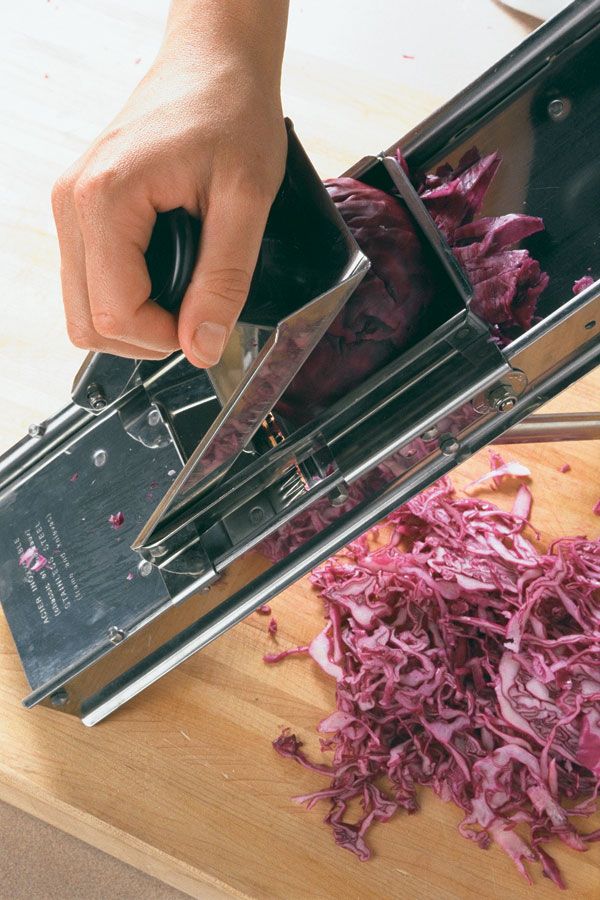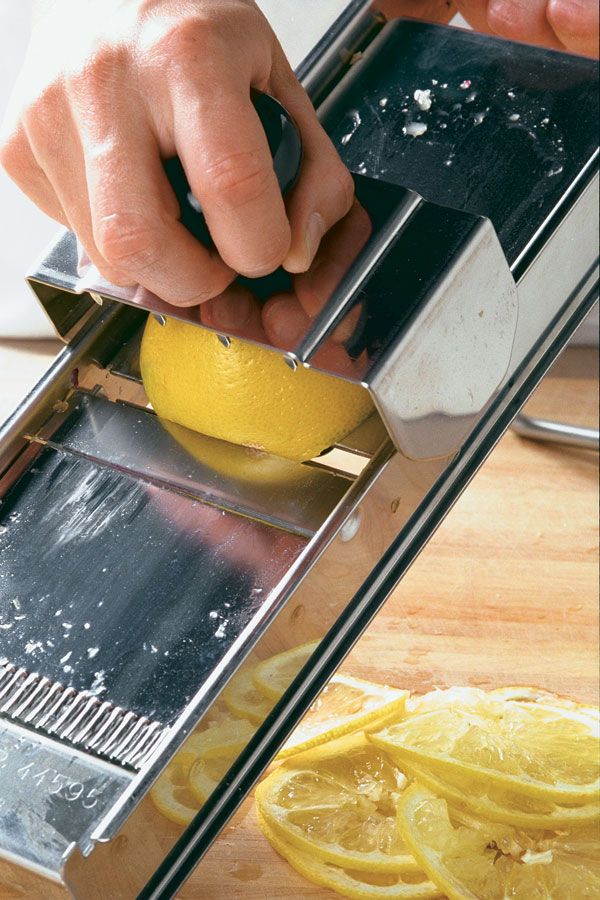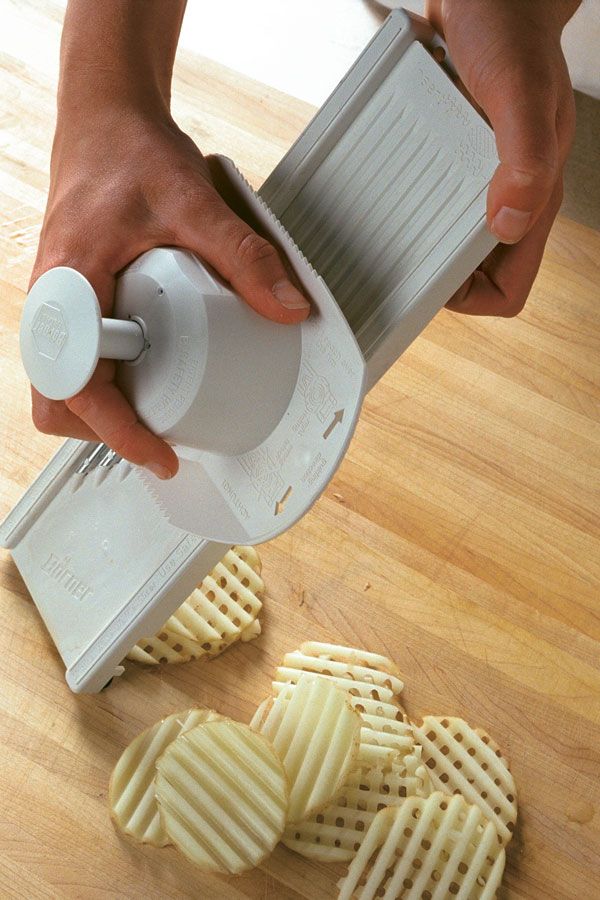
by Ken Haedrich
August 1997
from issue #10
Though I’m a firm believer in the principles of small is beautiful and less is more, that’s never stopped me from indulging in a rather detailed fantasy about the kitchen I’d like to have. Somehow within this kitchen of my dreams has always been a tool called the mandoline, though I’m at a loss to explain the exact nature of my attraction to a gizmo that looks more like a guillotine on the bias than a musical instrument. It has, I suppose, at least something to do with the thing’s mellifluous moniker, its European pedigree, and hefty price tag (top-of-the-line ones can go for close to $200).
In case you’re wondering just what a mandoline does, well, it cuts; it’s a manual precision cutting tool. Unlike a knife, where you move the blade over your food, with a mandoline you direct the food over a stationary blade. It’s actually quite a clever arrangement, and that’s all I knew about mandolines until I had the opportunity to test drive three models. I wanted to see just how they performed and to answer some questions I’ve always had about them, such as: Does a mandoline make sense for the home cook? Or is it really more suited to the professional kitchen? Are they safe? Easy to operate? And, when all is said and done, are they really worth the dough?
Lest you imagine that a mandoline is some sort of savior for those wary of knives, that’s simply not the case. First, the mandoline, though versatile, could never replace your knives. The mandoline excels only within a narrow job description, primarily slicing vegetables and certain fruits uniformly or decoratively. Secondly, each of the mandolines I used has a sufficient number of exposed slicing edges so that bodily injury is always a possibility, either when using the machine or just cleaning it.
The mandolines I tested included the Boerner V-Slicer (distributed by Swissmar Imports), the imported Matfer mandoline (distributed by Matfer Bourgeat), and another import known as the Bron (distributed by chefsdirect.com).
I was prepared to dismiss the German-made Boerner V-Slicer almost from the moment I laid eyes upon it. This was not the machine one would expect from the country that gave us the Mercedes, but a light-duty plastic unit.
If you’ve ever scraped your fingertips or knuckles on a grater, you’ll appreciate why each of the mandolines comes with some sort of safety holder to secure the food you’re cutting. The V-Slicer’s looks like a 10-gallon hat; in the crown are several metal spikes on which the food you are slicing is impaled. The business portion of the mandoline—the V-frame—is a rectangular piece of plastic with a gaping, bladed V-notch in the center. Using interchangeable inserts, you can make thin and thick slices, thick waffle cuts, julienned or diced vegetables. The whole contraption stores in what they call a multi-box and there’s an optional catch-all bowl available; you lay the mandoline directly over the bowl and slice horizontally, so the slices fall right into the bowl.
Without the optional bowl, you simply hold the V-frame on the diagonal with one hand, while grasping the safety holder with your other. To slice the food, you slide the safety holder rapidly up and down the frame. At first, this arrangement felt rather awkward because there’s no track to guide the safety holder; it just floats over the surface like a Ouija on speed. In time, however, I got used to the feel of it.Both the Bron and Matfer mandolines take the issue of stability a good deal more seriously, as well they should, given their substantially greater cost. Instead of having to hold them on a slant, both rest on their own folding stand.
They work on the same principle all mandolines do—food travels over fixed blade—but there are several noteworthy design differences, most comforting of which is the Bron’s “chariot.” The Bron has a rail tracking system to help secure the food as you slice; the chariot is the Bron’s hinged holder in which your ingredients sit as the chariot rides up and down the rails. You just grasp the lid by the handle and slide; your hand remains well out of harm’s way. The one drawback is that you can’t use the waffle slicer with the chariot; for that, you must hold the food right in your hand.
This chariot system is so effective I can’t figure out why the design folk at Matfer haven’t adopted it. Instead, they include a spiked U-shaped pusher that rides just outside the frame of the mandoline. For overall stability and peace of mind this can’t match the Bron’s chariot, but again, the more I used the Matfer mandoline, the less cumbersome it felt.
Once I got the hang of each mandoline, I found that all of them did a good job with their assigned tasks. I made coleslaw, scalloped potatoes, and razor-thin slices of lemon, then sliced carrots and julienned zucchini. In each of these areas, the machines performed more or less equally. The V-Slicer can cut only thick or thin slices; the other mandolines allow precision adjustments in the thickness of your cuts (then again, the V-Slicer is considerably less expensive). Generally speaking, I liked the Bron’s cutting design more than Matfer’s. All of the Bron’s blades and slicers are built right into the frame, whereas Matfer’s three cutting blades must be changed manually.
Before you buy a mandoline, it makes sense to ask yourself how often you’re likely to use a machine whose sole purpose is to make uniform slices. If you’re handy with a knife and seldom cook for a crowd, you can probably live without one. On the other hand, if you have a big family, like to throw parties, make tons of French fries, potato chips, scalloped potatoes, or large batches of sauerkraut, a mandoline might be a good time-saving investment.




















Comments
Log in or create an account to post a comment.
Sign up Log in